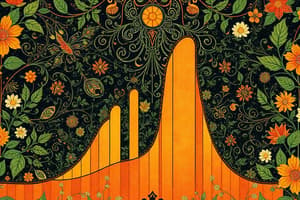Podcast
Questions and Answers
What is one potential source of bias in sampling?
What is one potential source of bias in sampling?
- Omitting hard-to-reach groups (correct)
- Utilizing a diverse sample frame
- Using a state-of-the-art sampling technique
- Increasing response rates
At which step of the scientific method is a hypothesis generated?
At which step of the scientific method is a hypothesis generated?
- Before formulating research questions
- When collecting data
- During data analysis
- After making an observation (correct)
Which of the following methods could reduce sampling bias?
Which of the following methods could reduce sampling bias?
- Replacing individuals difficult to contact
- Expecting low response rates
- Using an updated sample frame (correct)
- Deviating from pre-agreed sampling rules
What characterizes a scientifically sound hypothesis?
What characterizes a scientifically sound hypothesis?
Which of the following is NOT a recognized potential source of bias in sampling?
Which of the following is NOT a recognized potential source of bias in sampling?
In the scientific method, what is the primary purpose of making an observation?
In the scientific method, what is the primary purpose of making an observation?
What can happen if a sample frame is outdated in sampling methods?
What can happen if a sample frame is outdated in sampling methods?
What is an important aspect of a hypothesis in scientific research?
What is an important aspect of a hypothesis in scientific research?
What is the primary purpose of biostatistics?
What is the primary purpose of biostatistics?
Which of the following can be classified as a quantitative variable?
Which of the following can be classified as a quantitative variable?
Which term describes a variable whose values arise from chance factors?
Which term describes a variable whose values arise from chance factors?
What is not a common source of data in biostatistics?
What is not a common source of data in biostatistics?
Which of the following statements about discrete random variables is accurate?
Which of the following statements about discrete random variables is accurate?
What type of data does biostatistics primarily deal with?
What type of data does biostatistics primarily deal with?
Which characteristic defines a qualitative variable?
Which characteristic defines a qualitative variable?
From where can data be sourced for biostatistical analysis?
From where can data be sourced for biostatistical analysis?
What characterizes a continuous random variable?
What characterizes a continuous random variable?
What is the simplest definition of a population in biostatistics?
What is the simplest definition of a population in biostatistics?
Which measurement scale allows for ranking but does not provide the distance between ranks?
Which measurement scale allows for ranking but does not provide the distance between ranks?
In which measurement scale are observations classified into mutually exclusive categories without any order?
In which measurement scale are observations classified into mutually exclusive categories without any order?
What distinguishes the interval scale from the nominal scale?
What distinguishes the interval scale from the nominal scale?
Which of the following is NOT an example of a measurement scale?
Which of the following is NOT an example of a measurement scale?
What can be defined as a part of a population?
What can be defined as a part of a population?
Which of the following measurement scales has the highest level of sophistication?
Which of the following measurement scales has the highest level of sophistication?
What characterizes the ratio scale of measurement?
What characterizes the ratio scale of measurement?
Which of the following is an example of a trait typically measured using the ratio scale?
Which of the following is an example of a trait typically measured using the ratio scale?
What is the main purpose of statistical inference?
What is the main purpose of statistical inference?
Which method is NOT a type of probability sampling?
Which method is NOT a type of probability sampling?
What defines simple random sampling?
What defines simple random sampling?
How is systematic sampling conducted?
How is systematic sampling conducted?
Which statement is true regarding probability sampling methods?
Which statement is true regarding probability sampling methods?
What distinguishes non-probability sampling from probability sampling?
What distinguishes non-probability sampling from probability sampling?
Which of the following is a feature of stratified random sampling?
Which of the following is a feature of stratified random sampling?
What is a primary disadvantage of convenience sampling?
What is a primary disadvantage of convenience sampling?
Which sampling method selects whole subgroups, or clusters, for inclusion in the study?
Which sampling method selects whole subgroups, or clusters, for inclusion in the study?
What is the main characteristic of non-probability sampling methods?
What is the main characteristic of non-probability sampling methods?
In probabilistic sampling methods, which method ensures that every individual has an equal chance of being selected?
In probabilistic sampling methods, which method ensures that every individual has an equal chance of being selected?
Why might stratified random sampling be preferred over simple random sampling?
Why might stratified random sampling be preferred over simple random sampling?
Which of the following sampling methods is most likely to generate biased results?
Which of the following sampling methods is most likely to generate biased results?
What does clustered sampling primarily use as the sampling unit?
What does clustered sampling primarily use as the sampling unit?
Flashcards are hidden until you start studying
Study Notes
Bias in Sampling
- Five key sources of sampling bias must be considered when selecting samples, regardless of the method used.
- Deviating from pre-established sampling rules can introduce bias.
- Hard-to-reach demographics may be excluded from samples.
- Replacing selected individuals can lead to unrepresentative samples.
- Low response rates can skew the results, impacting the validity of findings.
- Using outdated sample frames can omit recent movers and create bias.
The Scientific Method
- A systematic approach to collecting, analyzing, and reporting scientific data to yield unbiased, replicable results.
- Step 1: Making an Observation - Focus on a phenomenon leading to scientifically testable questions.
- Step 2: Formulating a Hypothesis - Develop hypotheses to explain observations, often involving extensive background research.
Basic Concepts in Biostatistics
- Data is defined as numbers and is the foundation of statistical analysis.
- Statistics involves the collection, organization, summarization, analysis of data, and drawing inferences from samples.
- Sources of data can include routinely collected records, surveys, experiments, and external sources.
- Biostatistics specializes in data from biological sciences and medicine.
Types of Variables
- A variable represents characteristics that can assume different values across individuals or situations.
- Quantitative Variables are measurable (e.g., height, weight).
- Qualitative Variables categorize individuals or objects based on attributes (e.g., ethnicity).
- Random Variables produce values impacted by chance, while Discrete Random Variables have gaps in possible values.
- Continuous Random Variables can take any value within a range.
Sampling and Inference
- Statistical inference concludes about a population based on a sample.
- Sampling strategies are divided into probability and non-probability methods.
Probability Sampling Methods
- Simple Random Sampling: Every subset of the population has an equal chance of selection.
- Systematic Sampling: Individuals are selected at regular intervals from the sampling frame (e.g., every nth individual).
- Stratified Random Sampling: Population divided into subgroups (strata) to ensure representation of different characteristics.
- Clustered Sampling: Entire clusters are randomly chosen as sampling units instead of individual members.
Non-Probability Sampling Methods
- Convenience Sampling: Participants selected based on availability; while easy, it risks significant bias since volunteers may differ from non-volunteers.
- Quota Sampling: Ensures specific characteristics in the sample mirror the population.
- Judgement (Purposive) Sampling: Researchers select participants based on specific criteria.
- Snowball Sampling: Existing subjects recruit future subjects, useful for hard-to-reach populations but risks bias due to non-random selection.
Measurement and Measurement Scales
- Measurement assigns numbers to objects or events according to defined rules.
- Nominal Scale: Classifies observations into distinct categories without order.
- Ordinal Scale: Ranks categories with an implied order.
- Interval Scale: Values have defined distances between them but lack a true zero.
- Ratio Scale: Highest measurement level with a true zero, allowing for comparison of ratios.
Studying That Suits You
Use AI to generate personalized quizzes and flashcards to suit your learning preferences.




